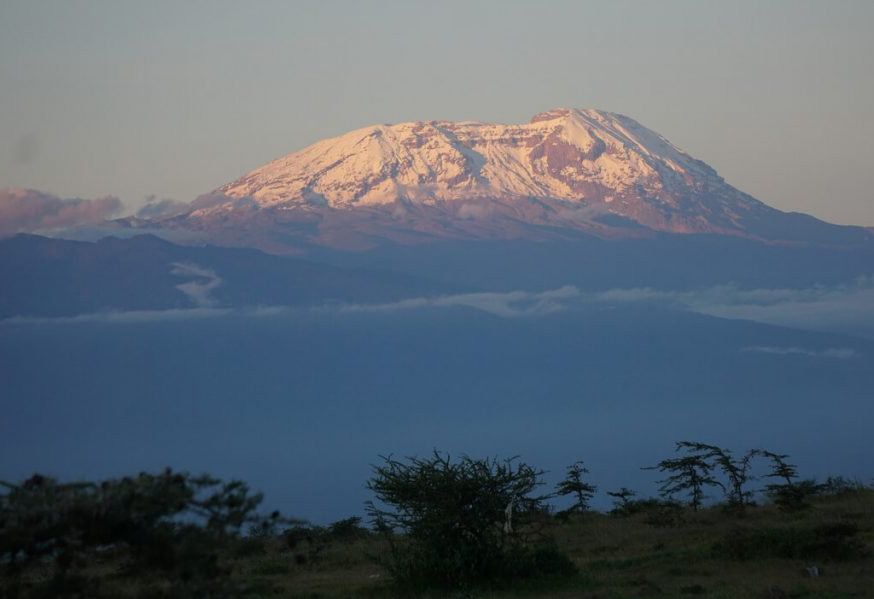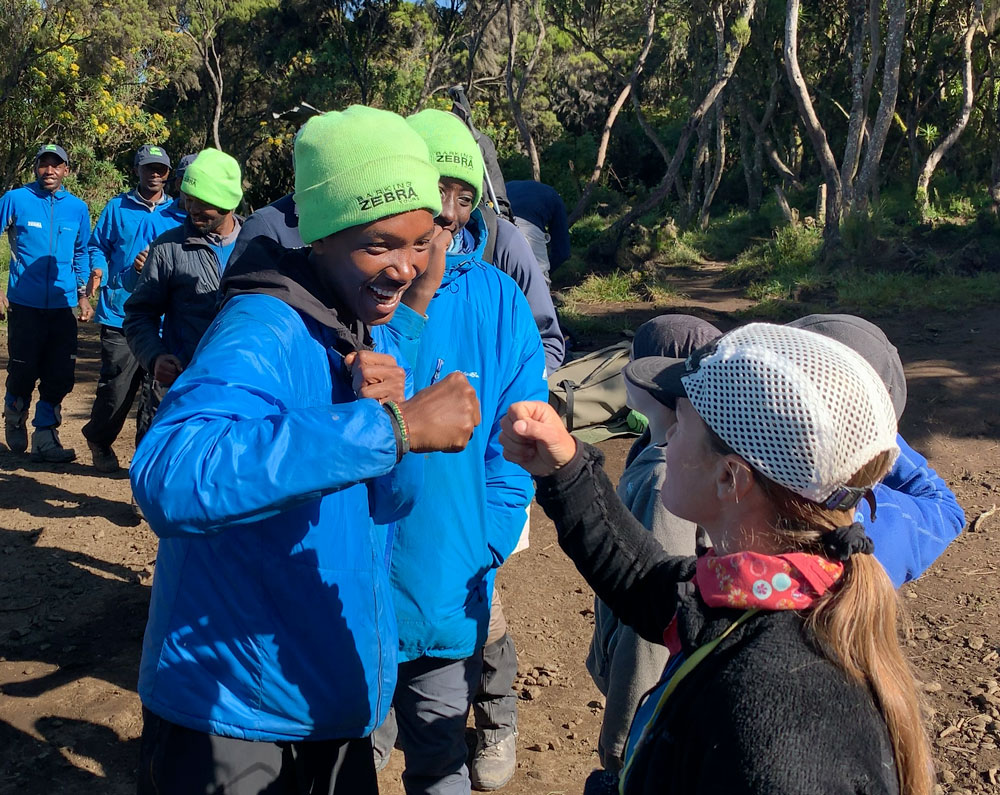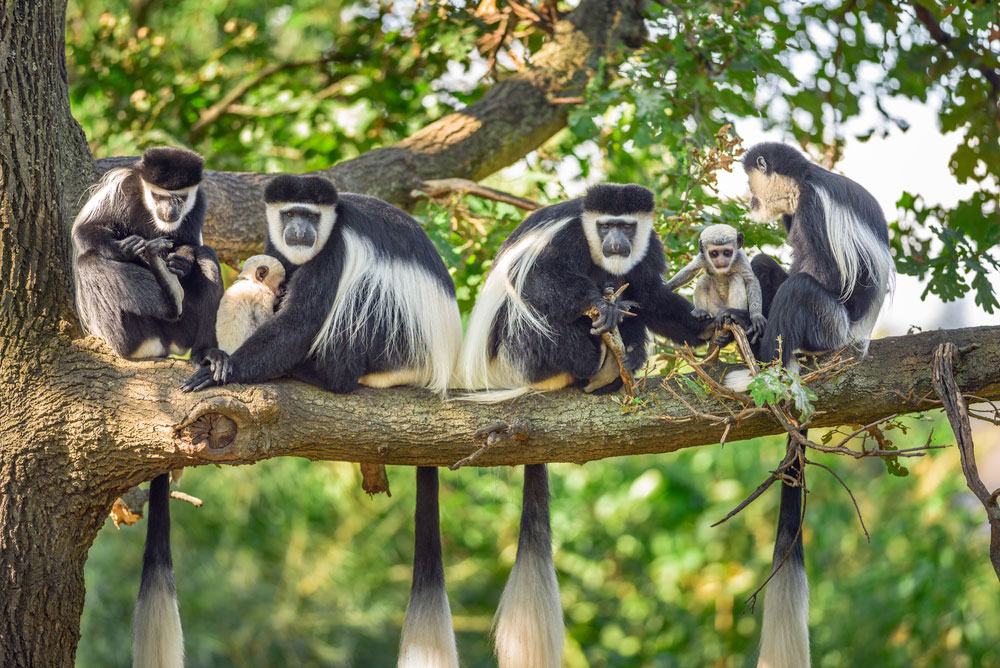Quick Details
Join the International Mountain Climbing School Guide Craig John for an incredible trek to the summit of Mount Kilimanjaro, followed by a safari in the world’s cradle of wildlife.
Craig John has guided Mount Kilimanjaro over 25 times, and has 60+ high altitude expeditions to Alaska, the Himalaya, the Andes, and beyond. He is joined by an in-country team of expert guides, porters, and cooks designed to ensure your climb is safe and successful.
Kilimanjaro Machame Route (7-Day)
Machame route’s initial approach is from the south, allowing for excellent acclimatization and exceptionally diverse scenery. Each day on this route presents quite a distinct ecosystem to experience, which is why it is so popular. The route offers gradual acclimatization to the altitude and an excellent chance of reaching the summit.
The ascent begins at Machame Gate, through lush rainforest, and continues across the Shira Plateau, which offers stunning views of Mt. Mawenzi and Mt. Meru. At Shira Camp, it joins the Lemosho route from the west, and the summit push is from the Barafu Camp.
The descent is via the Mweka route and through Mweka Gate. No technical climbing is required, but a good level of fitness is highly recommended! Check out the Machame Route Map.
Wildlife Safari (4 Days / 3 nights)
No visit to Tanzania is complete without a wildlife safari. During these four days, you’ll see some of the world’s most iconic wildlife. We’ll visit Lake Manyara National Park, Ngorongoro Crater, and Tarangire National Park, each with their own unique features, flora, and fauna.
During the safari, we’ll spend two nights in the luxurious Acacia Farm Lodge and one night in luxury tents at Nyikani Camp Tarangire.
ABOUT YOUR EXPEDITION
-
The “Roof of Africa,” Mt Kilimanjaro is not only Africa’s highest peak at 19,341 ft (5,895 m), but also one of the world’s highest volcanoes and the world’s tallest walkable mountain. No climbing equipment is needed to reach the peak, but that doesn’t mean it’s easy.
Climbers ascend through five different ecological zones, each with its unique flora and fauna. It’s the world’s highest free-standing mountain, offering a chance to climb from the equator to arctic conditions in a matter of days.
Hundreds of bird species and various animals live in the forests of the southern slopes and surrounding areas, including black and white colobus monkeys. It is also home to the Chagga people, who rely on its rich volcanic soil and bountiful supply of pure spring water for their agricultural livelihood.
Although positioned close to the equator, just 200 miles south (330 km), Mt Kilimanjaro is snow-capped, and its glaciers tower majestically over the savannah plains. It has three volcanic cones situated near the fault-line of two tectonic plates: Mawenzi, Shira, and Kibo.
Kibo is the tallest and dormant, while the other two are extinct. It’s estimated that Shira’s peak once stood at least 16,000 ft (4,875 m) high before it collapsed to form what is known as the “Shira Plateau.” Kilimanjaro’s highest summit is Uhuru Peak, located on Kibo’s crater.

-
Porters, who carry all of your food and gear, are the heart and soul of your mountain experience. Without their strength, dedication and hard work, you would not be able to enjoy the magnificence of Kilimanjaro.
By choosing to climb with IMCS and our in-country partners Barking Zebra Tours, you ensure that the porters you work with on your climb have fair wages and ethical treatment of mountain crew.
Barking Zebra uses top of the line expedition equipment to ensure your comfort on the mountain. All guides have Wilderness First Responder training, and perform daily health checks with each individual in the group. Meals are planned for the right balance of protein, carbohydrate, and nutrients to support your climb.

-
Climbing Mount Kilimanjaro is a challenging trek that requires good physical condition but doesn’t demand technical climbing skills. The main challenges are:
– Extended periods of uphill walking (6-8 hours daily)
– High altitude conditions (up to 19,341 ft/5,895m)
– Varying terrain and weather conditions
– Multiple consecutive days of physical exertionHealth Conditions to Consider and Discuss with Your Doctor
– Heart conditions
– Respiratory issues
– Joint problems
– High blood pressure
– Diabetes
– Previous altitude sicknessRemember: The better prepared you are physically, the more you’ll enjoy the experience and the higher your chances of reaching the summit. We can suggest a training regimen, and guide you on preparatory hikes in the Mount Washington Valley.

-
Visas: Tourists must obtain a one-year multiple entry visa for $100. Applicants can apply and pay online for an e-visa in advance of travel. If approved, the applicant will receive a “grant notice” via email which they present to the Immigration Officer upon arrival at the airport in Tanzania. U.S. citizens can also obtain a tourist visa upon arrival.
Tanzania Entry Requirements:
– Passport with at least one blank page and six months’ validity.
– Visitors must present a round-trip ticket and be prepared to demonstrate they have sufficient funds for their stay.
– Passports with the “X” gender marker are not accepted.Visit the US Department of State travel page for Tanzania for more information.
-
Check the vaccines and medicines list and visit your doctor at least a month before your trip to get vaccines or medicines you may need.
Proof of yellow fever vaccination is not required from travelers from the US. It is required from all travelers arriving from countries where the disease is endemic, including 12+ hour airport transit and layovers. The Embassy of Tanzania has further information, including on waivers for this requirement.
Visit the CDC page for Tanzania for more information. If you or your doctor need help finding a location that provides certain vaccines or medicines, visit the Find a Clinic page.
-
Deposit & Payments
– $1,500 non-refundable deposit / admin fee required to confirm booking
– Payments able to be made in installments
– Final payment due 90 days before departure dateCancellations
We understand that life happens. However, the logistics involved in planning expeditions require a tremendous amount of administrative work and time.
– Any cancellation 120+ days prior to the first date of your expedition will be refunded in full, minus the non-refundable deposit
– If you cancel 120-90 days prior to the first day of your expedition you will be refunded 50% of the total, minus non-refundable deposit
– We are unable to refund if you cancel within 90 days of your trip
– No refunds will be given for unused hotel bookings due to schedule changes, late arrivals, etc.IMCS reserves the right to cancel an expedition prior to the departure date. In the event that the expedition is canceled based solely on an internal administrative decision by IMCS, you will receive a full refund minus the non-refundable deposit.
We reserve the right to alter the climbing or safari route for safety/weather, and would substitute accommodations of similar standard if necessary. We will not compensate for unavoidable changes in the schedule.
IMCS Guides have the final authority on all safety decisions and reserve the right to terminate the climb for a multitude of reasons. This may include safety, weather, conditions encountered on the route, your personal level of fitness or ability, the abilities of your teammate(s) or any number of other circumstances. There is no guarantee that we will reach the summit. There are no refunds if the climb is terminated. Force majeure conditions apply. If we have to cancel the trip due to external factors, such as political upheaval, pandemics, terrorism, or cancellations imposed by foreign or domestic governments, we will not issue a refund.
Insurance
– Comprehensive travel insurance is mandatory
– Must include: Emergency medical evacuation (minimum coverage $500,000); Trip cancellation; Mountain rescue; COVID-19 coverage
– Copy of insurance policy must be received 30 days before departureLiability
– Limited to gross negligence
– IMCS is not liable for third-party services
– IMCS is not responsible for loss/damage of personal items
– Guests are responsible for their own actions and are liable for willful damage to property/equipment
– Guests must follow guide instructionsMarketing
– IMCS has the right to take and use photos/videos for marketing
– Client may opt out in writingPersonal responsibility
Clients are responsible for making all necessary preparations to ensure good health and physical conditioning for this expedition. Prior to departure, you are required to familiarize yourself with all pre-departure information and gather appropriate clothing and equipment for your climb.
Clients must maintain basic hygiene and treat both team members and local populations with respect. Guides retain the authority to remove any team member whose actions jeopardize the health or safety of others during the trip.
ITINERARY
-
Meet & Greet at Kilimanjaro airport
Private transfer to hotelMeals: Dinner on arrival

-
Pre-climb briefing and gear check
Relax in the afternoon; option to tour ArushaMeals: B/L/D (Breakfast, Lunch, Dinner)

-
After breakfast, we depart to Kilimanjaro National Park. Driving past the banana and coffee plantations, we arrive at the trailhead – Machame gate, where you will sign in at the National Park office. Our climb will start by immediately entering the rainforest and beginning the Machame route. Enjoy listening to many exotic birds in the canopy above and spotting black & white colobus monkeys.Machame Gate: 5,700 ft | 1,737mMachame Camp: 9,350 ft | 2,850mHiking Distance: 7 miles | 11 kmHours of trekking: 5 to 7Habitat: RainforestMeals: B/L/DOvernight Machame Camp

-
This morning we leave the last glades of the rainforest behind. Vegetation gets sparser as we ascend into the heath. After a couple of hours, we pass the first Lobelia and reach the Shira Plateau – a high-altitude desert plateau. Shira is the third of Kilimanjaro’s volcanic cones. A slow and steady ascent allows for our bodies to acclimatize to the higher altitude as we cross Shira Plateau.Shira Camp: 12,500 ft | 3,810 mHiking Distance: 3 miles | 5 kmHours of trekking: 4-6Habitat: MoorlandMeals: B/L/DOvernight Shira Camp

-
The trail becomes a bit rocky and strenuous as we get closer to the Lava Tower, a 300 ft tall volcanic tower. We have lunch at Lava Tower at 15,190 ft/4,630 m to help our bodies acclimatize to the thin air. This is where the Machame and Lemosho routes converge, so we meet other climbers ascending the Lemosho Route.
After lunch, we descend to Giant Senecio Valley to Barranco Camp. Although we end the day at a lower elevation than we started, this day is significant for acclimatization. The view of the Western Breach from camp is spectacular.
Barranco Camp: 13,045 ft | 3,976 m
Hiking Distance: 6 miles | 10 km
Hours of trekking: 6 to 8
Habitat: Moorland/Alpine Desert
Meals: B/L/DOvernight Barranco Camp

-
Today our first challenge is to hike up the Barranco Wall, a 500 ft lava flow. It is a quite spectacular looking obstacle, which in the end usually turns out easier than how it appears. The views of crags and crevasses are stunning from the top of the wall. We continue to walk up and down a greener valley to Karanga camp.
Karanga Camp: 13,105 ft | 3,994 m
Hiking Distance: 3 miles | 5 km
Hours of trekking: 4 to 5
Habitat: Alpine Desert
Meals: B/L/DOvernight Karanga Camp

-
As we begin trekking today the trail turns steadily uphill. The temperature will grow colder and the landscape more sparse on the Machame route as we work our way to Barafu Camp. Barafu means “ice” in Swahili. The camp is set on an exposed ridge and is the staging point for our push to the summit.
The peaks of both Mawenzi and Kibo can be seen from the camp.
Barafu Camp: 15,330 ft | 4,673 m
Hiking Distance: 2 miles | 4 km
Hours of trekking: 4 to 5
Habitat: Alpine Desert
Meals: B/L/DOvernight Barafu Camp

-
We’ll be up before midnight to set out for the glacier zone atop Kilimanjaro. Walk slowly, drink plenty of water and refuel with small snacks to keep our energy high until we reach the summit.
We celebrate our success with a few quick pictures at the top before trekking much of the way back down the mountain. Gaiters and trekking poles come in handy for the loose gravel going down.
Mweka Camp is situated in the upper forest and mist or rain can be expected in the late afternoon.
Uhuru Peak: 19,341 ft | 5,895 m
Distance: 3 miles | 5 km
Hours of trekking to Uhuru Peak: 7-8
Habitat: ArcticMweka Camp: 10,065 ft | 3,067 m
Distance: 7 miles | 12 km
Hours of trekking to Mweka Camp: 5-6
Habitat: Moorland
Meals: B/L/DDaytime Summit Bid (Optional)
We start climbing a couple of hours before sunrise. That way, you climb during daylight on the steepest and most demanding part of the mountain. We overnight at Millennium Camp.Millennium Camp: 12,500 ft | 3,810 m
Distance: 6 miles | 10 kmHours of trekking to Millennium Camp: 5-6
Habitat: Moorland
Meals: B/L/DOvernight Millennium or Mweka Camp

-
After breakfast, descend through the montane forest to Mweka gate. Celebrate your achievement with your mountain crew, thanking your guides and porters and acknowledging their hard work and contribution to your success.
After lunch at Mweka gate, transfer back to hotel for a well-deserved shower and dinner.
Mweka Gate: 5,380 ft | 1,640 m
Hiking Distance: 6 miles | 10 km
Hours of trekking: 3 to 4
Habitat: Rainforest
Meals: B/L/D
-
From the hotel, drive to Lake Manyara National Park (approximately 2.5 hours). Picnic lunch in the park.
Lake Manyara National Park offers a wilderness experience in diverse habitats, from its Rift Valley soda lake to dense woodlands and steep mountainsides. Beyond its spectacular setting, the park is famous for its unusual tree-climbing lions and the vast elephant herds it was established to protect.
The shores of the lake attract more than 400 species of birds, many of them waterfowl or migrants. Giraffes, impalas, and herds of buffalo roam the lake shores and the forested valley slopes.
Meals: B/L/D
Overnight at Acacia Farm Lodge (2 nights)

-
Early morning descent to Ngorongoro Crater for a full-day game drive. Picnic lunch on the verdant crater floor.
The Ngorongoro Crater, often described as the ‘Garden of Eden,’ is an extinct caldera measuring between 10 and 12 miles across, making it one of Africa’s iconic highlights. This three million-year-old crater was once a colossal volcano, some suggesting it was even higher than Mt Kilimanjaro. Today, it stands as the largest intact caldera in the world and is recognized as a UNESCO World Heritage site.
It contains possibly the largest permanent concentration of wildlife in Africa, with an estimated average of 30,000 large mammals, including black rhinoceros, lions, leopards, elephants, zebras, hippo, cheetah, a variety of antelope, flamingo, and a large variety of birdlife.
Meals: B/L/D
Overnight at Acacia Farm Lodge (2 nights)

-
Drive to Tarangire National Park (approximately 2 hours). Picnic lunch in the park.
With awe-inspiring, almost prehistoric baobab trees, colossal termite mounds, and abundant elephant populations, Tarangire offers a truly distinct contrast to the renowned Serengeti National Park and the Ngorongoro Crater. Visitors can immerse themselves in a genuine wilderness experience while savoring exceptional wildlife viewing.
Within the heart of the park, the Silale swamp takes center stage as the principal water source, drawing in elephants and predators as the dry season progresses. There is a healthy lion population, and the other predators are often spotted trailing the plains game as they head to the water.
On occasion, you can catch a glimpse of these feline predators reclining in the branches of sausage trees.
The diverse habitats of Tarangire, such as riverine forests, grasslands, and swamps, contribute to the park’s rich avian biodiversity. Over 500 bird species have been recorded in this area. Birdwatchers visiting Tarangire may have the opportunity to spot species like the yellow-collared lovebird, ashy starling, African fish eagle, barbet and mousebirds and many more.
Baobabs stand as the defining icons of Tarangire, colossal and column-like, guarding the plains like ancient sentinels. Some of these remarkable giants have endured for over 1,500 years, surpassing the size of any other baobab species worldwide, and they thrive in exceptionally dense numbers in Tarangire. As a result, the park has earned the unofficial title of “Baobab Capital of the World.”
Meals: B/L/D
Overnight at Nyikani Camp Tarangire

-
Slowly make your way back to Arusha to your lodge, where you will reunite with your Kilimanjaro gear. Dayroom at hotel to shower and prepare for travel.
After dinner, transfer to Kilimanjaro Airport.
Meals: B/L/D
Dayroom at hotel.
What is included / excluded?
Inclusions:
– Kilimanjaro National Park and camping fees (subject to change without notice)
– Enrollment with AMREF Flying Doctor’s Evacuation Insurance
– Meals in Arusha as specified per itinerary
– 24-hour support in Arusha
– Airport transfers
On the mountain:
– Professional English-speaking guides, trained as Wilderness First Responders
– Dedicated mountain crew
– Emergency equipment: oxygen, portable stretcher, oximeter, comprehensive medical kit, and Gamow bag (portable altitude chamber)
– Expedition sleeping tents
– Solar-lit dining tents
– Three daily meals prepared by professionally trained chefs
– Fresh food re-supply half-way through the expedition
– Unlimited purified water
– Hot basins of water provided daily
– Closed-cell foam sleeping pads
– Small pillow and dry-bag (to protect your duffel)
– Hygienic portable toilet tents (according to group size)
Exclusions:
– International flights to Kilimanjaro
– Visa and passport fees
– Trip cancellation and health insurance
– All Covid related testing charges
– Personal hiking gear
– All items of a personal nature such as additional meals, alcoholic and non-alcoholic beverages, activities not specified, curios, etc.
– All services and charges due to early descent from the mountain
– Any options not described in the itinerary
– All gratuities, including mountain crew
